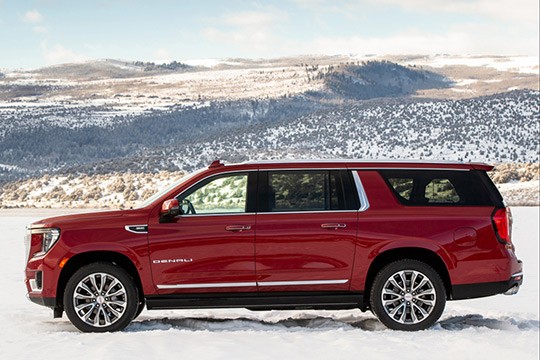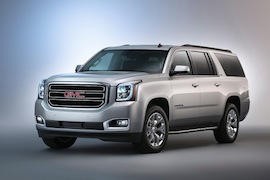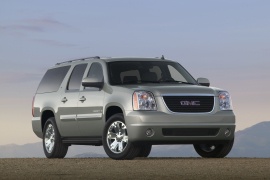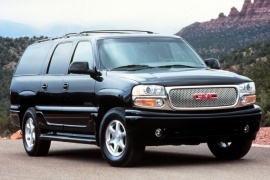GMC Yukon XL Models/Series Timeline, Specifications & Photos
First production year: 1999
Engines: Gasoline
Body style: SUV (Sports Utility Vehicle)
GMC introduced the fifth generation of the Yukon XL in December 2019, and it was based on the same platform as the Chevrolet Tahoe and Cadillac Escalade ESV.
While Escalade got the attention from superstars and the authorities preferred the Tahoe, the Yukon aimed to the regular Joe and Jane with a down-to-earth design. It was just a typical SUV for everyday people. Maybe not that regular, mostly if they were a big family.
The fifth-generation was completely redesigned, and it was available in two length versions: the Yukon and the Yukon XL. The latter was easy to spot due to its longer rear doors and its last row of windows. These were necessary due to the longer wheelbase. At the front, though, both vehicles wore the same C-shaped signature LED headlights and the broad grille with horizontal slats, where the GMC badge found its place. For the Denali trim level, the grille looked more like a chromed fence.
Inside, the XL version featured a sliding center console and room for up to nine people, depending on the seat options. In standard trim level, it offered space for seven in a 2+2+3 configuration. But according to the official statements, 60% of the Yukon customers chose the Denali version that featured all the bells and whistles GMC could provide. That included a 15” Head-up Display and a premium sound system that could compete with the equipment from your local country club.
GMC introduced full independent suspension for the Yukon with air-spring on all corners. That not only improved the comfort level, but it also added a touch of inspiration since the car could have been lowered for easier access. Under the hood, GMC dropped a choice of two engines: a 5.3-liter V8 and a 6.2-liter V8.
The large SUV Yukon was officially revealed to the public in 2013 and was expected to start selling with 2015.
The Yukon XL was built on the GMT K2XX platform, similar to the Chevrolet Suburban, but with a wider rear track.
The imposing large SUV was pretty much square shaped, having a huge chrome grille with the GMC logo in red on it and chrome surrounds on the foglamps. The front parking sensors were integrated in the front bumper.
At the back, the Yukon had led brake lights and turn signals, along with the GMC badge in the middle of the trunk lid.
To make things easier, the Yukon had a power lift gate that was actioned by the button on the trunk lid and revealed a good size load area. If cargo area needed to be increased, the 3rd row was made of power folding seats with a quick response. The 3rd row seats could be folded using the buttons inside the trunk.
Loading heavy items in the Yukon’s trunk was a little difficult due to the car’s height.
Inside the large SUV we would find a refined interior, with heated and cool extremely comfortable seats, a leather wrapped steering wheel that was also heated, nice and simple dial gauges as well as a touchscreen display that could also show navigation if available.
The glovebox was of a decent size, as well as the numerous cupholders and smaller storage spaces in the door panels.
The 2nd row seats offered good legroom and headroom, while the 3rd row seats were only adequate for children due to the limited legroom.
GMC introduced the Yukon XL at the 2007 Los Angeles International Auto Show. It was one of the most luxurious cars in the American carmaker lineup.
The Yukon's third-generation shared its platform with the Cadillac Escalade, and GM made it to fill the gap between a large family SUV and a luxury vehicle. While the Yukon nameplate appeared for the first time in 1935 as a trim level for the Chevrolet Suburban, the vehicle became a separate lineup only in 1992. Like its predecessors, the Yukon was built on the same chassis as the Chevrolet Silverado and GMC Sierra pickup truck, which could handle heavy loads.
GMC installed a pair of big headlights with corner-mounted turn-signals. It was the same front fascia as the rest of the Yukon lineup with a black mesh-grille and red lettering for the brand's name. Some would notice the longer wheelbase and the extended cab behind the C-pillars that made a difference from the rest of the Yukon range from its sides. In the back, the big SUV featured vertically mounted taillights on the corners and blacked-out D-pillars.
Inside, the carmaker installed three seat rows with room for up to seven passengers. A nine-passenger version was on the options list. The second and last rows were available with a power-operating folding system that led to huge trunk space. At the front, the wide bucket seats were separated by a center console with a storage compartment big enough to store the food for a coast-to-coast trip, especially since it was cooled.
Under the hood, GM installed two engine options, both V8. For the base version, the Yukon XL featured a rear-wheel-drive as standard, while for the other two, the all-wheel-drive system was fitted as standard.
GMC introduced the Yukon XL on the extended chassis from the GMC Yukon, or the Chevrolet Tahoe, if you want, but it was more luxurious than both of them.
A longer wheelbase doesn't only make room for three rows of seats. It also increases the legroom for the rear passengers. With its huge experience in building SUVs, GMC tried to make the Yukon XL better for its occupants, even if that was translated into higher fuel consumption.
From the outside, the Yukon XL offered the same front fascia as its shorter cousin, with chromed grille and headlights surroundings. The longer rear windows were evident from its sides, and so were the specific chromed alloy wheels. Since it was based on the same chassis as the GMC Sierra pickup, the Yukon XL stood on the same size wheels.
Inside, there were numerous upgrades when compared to the standard Yukon. The car was designed to work for official agencies, and it was almost a luxury vehicle. GMC priced-it just below the recently introduced Cadillac Escalade. Inside, the big SUV was fitted as a standard in a seven-seat configuration.
Under the hood, GMC installed the LM7 engine on the standard version. The full-option model featured a 6.0-liter V-8 engine. For special applications and law-enforcement agencies, GMC offered an 8.1-liter V-8 unit. The four-speed electronically controlled.



